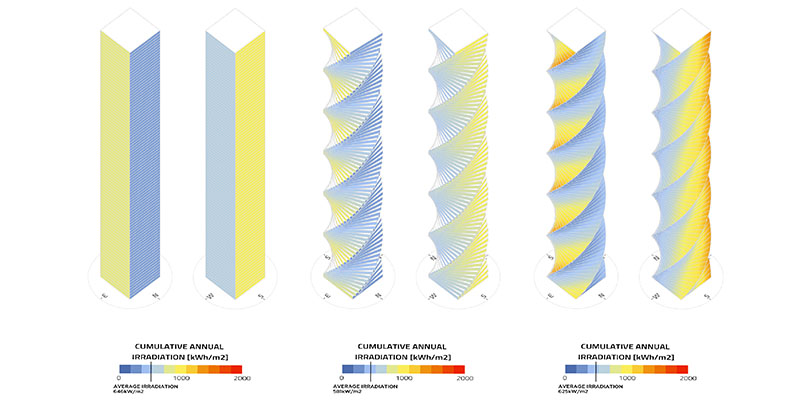Downloads
DOI:
https://doi.org/10.7480/jfde.2020.1.5043Abstract
Over the last number of decades, tall building geometries have been shifting from rectangular boxes towards shapes that are defined through geometrical transformations such as twisting. While, from an aesthetical point of view, these twisting geometries make tall buildings appear contemporary and iconic, from an environmental point of view, however, the benefits are not as straightforward. They may vary significantly based on climatic loads and urban conditions, among others.
This study aims to assess the self-shading benefits of twisting geometries by finding a correlation between floor-to-floor rotation and façade solar irradiation across climates, primarily focusing on hot ones, where self-shading is used as a passive solar design strategy. The study analysed three types of irradiation studies: Cumulative Annual Irradiation, Cumulative Harmful Irradiation during Cooling Design Day, and lastly, Solar Irradiation Self-Shading Balance. The latter compares beneficial and harmful solar irradiation during Hot and Cold Degree Days to quantify the impact of floor-to-floor rotation on optical and thermal performance. The study explored hundreds of possible scenarios across different climates and various floor-to-floor rotation angles, revealing a variety of positive, negative, and neutral situations. The study recommends careful examination of environmental conditions via a combination of multiple irradiation studies, particularly in the case of a smooth façade scenario.
How to Cite
Published
Issue
Section
License

This work is licensed under a Creative Commons Attribution 4.0 International License.
Authors or their institutions retain copyright to their publications without restrictions.
References
ASHRAE (2019). Standard 90.1. Energy Standard for Buildings Except Low-Rise Residential Buildings
ASHRAE (2013). ASHRAE/IES Standard 90.1-2013--Energy Standard for Buildings Except Low-Rise Residential Buildings. American Society of Heating, Refrigerating, and Air-Conditioning Engineers Inc., Atlanta.
Banke, T. (2013). Parametri i praksis: Generativ performance i arkitektur [Parametric design in practice - Generative performance in architecture]. (1 ed.). Retrieved from http://issuu.com/parametri/docs/afhandling_tore_banke_web/3?e=9673948/5357075
Capeluto, G. (2003). Energy performance of the self-shading building envelope. Energy and Buildings. 35. 327-336. 10.1016/S0378-7788(02)00105-6.
CTBUH (2016). Twisting Tall Buildings. International Journal on Tall Buildings and Urban Habitat, (III).
CTBUH (2019). Year in Review - The Skyscraper Center. Retrieved from http://www.skyscrapercenter.com/year-in-review/2019/ (Accessed: 28 March 2020).
CTBUH (2020). The Skyscraper Center. Retrieved from http://www.skyscrapercenter.com/compare-data/submit?type%5B%5D=building&base_region=0&base_country=0&base_city=0&base_height_range=4&base_company=All&base_min_year=2010&base_max_year=9999&comp_region=0&comp_country=0&comp_city=0&comp_height_range=4&comp_c (Accessed: 28 March 2020).
Frearson, A. (2013). Agora Garden by Vincent Callebaut. Retrieved from Dezeen https://www.dezeen.com/2013/04/05/agora-garden-by-vincent-callebaut/, (Accessed on 20 June 2020)
Frearson, A. (2012). Absolute Towers by MAD. Retrieved from Dezeen https://www.dezeen.com/2012/12/12/absolute-towers-by-mad/ (Accessed: 05 March 2020)
Givoni, B. (1969). Man, climate, and architecture. Amsterdam; London; New York: Elsevier Publishing Company Limited.
International Code Council (ICC), Building Officials, Code Administrators International, International Conference of Building Officials, & Southern Building Code Congress International. (2000). International energy conservation code. International Code Council.
Nikandrov, P. (2020). Philipp Nikandrov. Retrieved from https://www.philippnikandrov.com/evolution-tower (Accessed: 05 March 2020)
Olgyay, A., & Olgyay, V. (1957). Solar control and shading devices. Princeton: Princeton University Press.
Olgyay, V. (1963). Design with climate : bioclimatic approach to architectural regionalism. Princeton: Princeton University Press.
Reinhart, C. F. (2014). Daylighting handbook I: fundamentals, designing with the sun. Building Technology Press. ISBN 069220363X
US Green Building Council (2014). LEED v4 for building design and construction. USGBC Inc.
Vincent Callebaut Architectures (2020). Retrieved from Vincent Callebaut Architectures: http://vincent.callebaut.org/object/190320_taozhuyinyuansite/taozhuyinyuansite/projects (Accessed: 05 March 2020)
Vincent Callebaut Architectures (2020). Retrieved from Vincent Callebaut Architectures: http://vincent.callebaut.org/object/190320_taozhuyinyuansite/taozhuyinyuansite/projects (Accessed: 05 March 2020)
Vollers, K. J. (2005). High-Rise Buildings with Twisted Façades. CTBUH 2005 7th World Congress. New York.
